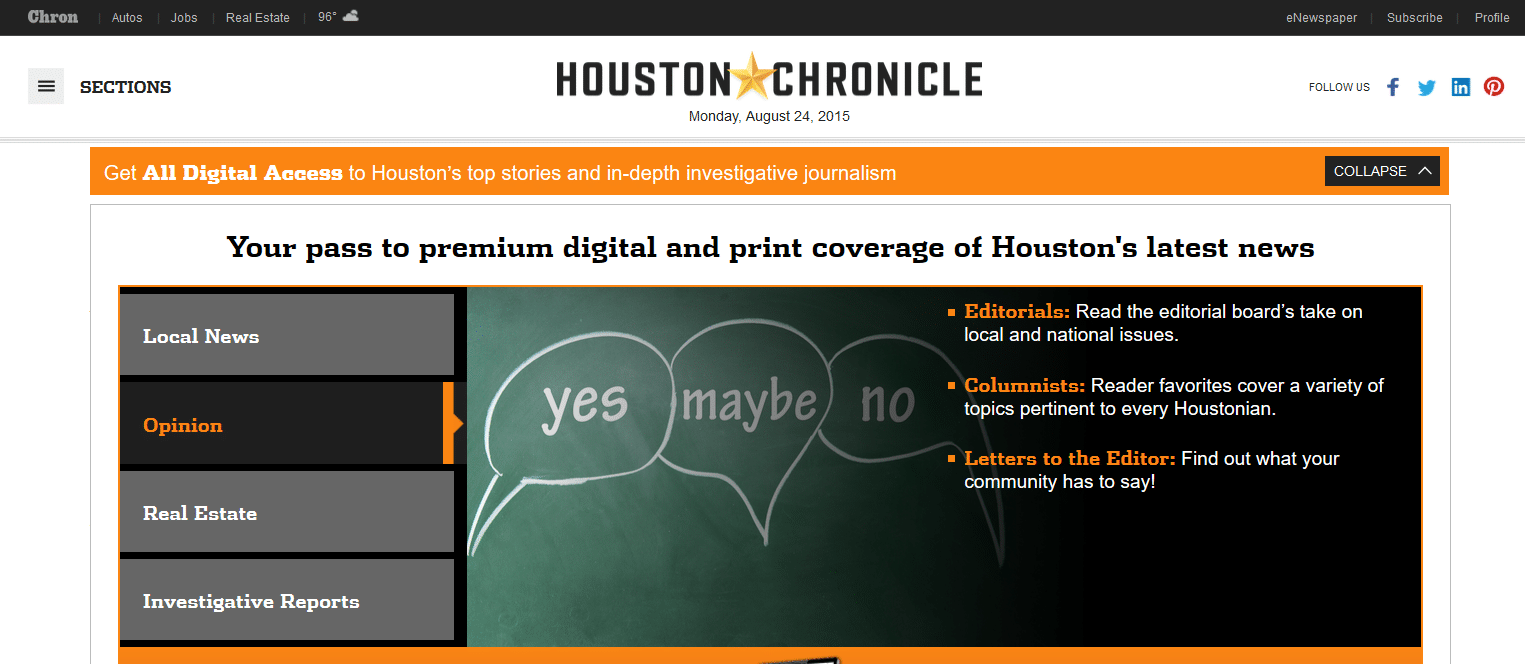Hearst’s Houston Chronicle overshadows the competition in a big way, says NetNewsCheck. In a detailed analysis of the Houston Chronicle, NetNewsCheck’s Patrick Duprey explains how the Chronicle’s two-site strategy – one paid, one free – is winning website visitors and subscribers over.Chron.com, the newspaper’s free website, attracted 14.5 million monthly visitors between January and June 2015, while its paid site HoustonChronicle.com averaged one million visitors for the same time period. Considering Houston’s population is only 6.8 million, those are some staggering web stats.

The experiment started in November 2012, says Duprey, when the Chronicle launched its paywall for $2.50/week for all digital access (the price is now $3.50/week). At the same time, the newspaper rolled out a membership program called Star Access that gave members unlimited access to the premium website, a digital replica of the daily paper, and iPad edition, and privileges at Chronicle events, discounts, deals, giveaways and more.

According to Duprey, the goal of the two websites was to use brand loyalty to woo print subscribers into becoming digital subscribers. The HoustonChronicle.com site is a bridge between print and digital, offering in-depth stories and higher quality digital experience, while Chron.com is trying to amass a large audience.A quick of review of yesterday’s website reveals more lifestyle and sensational news stories (pawn shop robbery, waterfront homes and revenge porn) and prominent ads on Chron.com versus a clean, organized, almost-ad-free experience on HoustonChronicle.com which offers a look back at Hurricane Katrina, political and sports news, and featured columnists.In Duprey’s article, Andrea Mooney, executive producer and director of digital content at the Chronicle, says Chron.com is mostly breaking news and other information like traffic and weather that are readily available on other sites. The paid site, however, has the newspaper’s enterprise stories, columnists and other quality content not available elsewhere.Some HoustonChronicle.com content is available for free – via search engine and social media traffic. In terms of ads, Duprey reports that Chron.com has three to seven ad units per page, versus one to two on HoustonChronicle.com.The two-site strategy is also being done by the San Francisco Chronicle, another Hearst-owned newspaper. SFGate.com is the newspaper’s free site, with a similar look and feel to Chron.com. SFChronicle.com is the newspaper’s paid site, featuring the newspaper’s enterprise stories and other exclusive content.According to Compete.com, SFGate.com had 11.9 million visitors in July 2015, compared to SFChronicle.com’s 789,000 visitors. Chron.com had 11.6 million visitors for the same time period, compared to HoustonChronicle.com’s 490,000 visitors. Translation: the free sites are generating huge numbers, while the paid sites are not.Insider Take:What does it all mean? It means that the Houston Chronicle is successful in its market and that Hearst is trying a similar strategy in other major metropolitan areas. Hearst’s free sites are trying to capture eyeballs with content that is probably curated from other sources. It is leveraging its brand to draw people in. With high web stats, Chron.com can command a better digital advertising rate, and if it’s lucky, the Houston Chronicle might even win over a few would-be subscribers.The paid site, on the other hand, is probably drawing long-time print subscribers who understand and want the exclusive content that the HoustonChronicle.com provides. These subscribers are willing to pay for a more visually appealing digital experience and for quality content.It seems like Hearst and its properties are trying to figure out what works and what doesn’t, and finding the perfect mix is likely to be different for each media outlet. While it works out the kinks, the Chronicle and other Hearst properties should be clear about what they’re offering to subscribers and nonsubscribers and to advertisers, sponsors and other partners. At first glance, the idea of a newspaper hosting and maintaining two websites is confusing.The Houston Chronicle is also experimenting with the membership model through its Star Access program, as a way to further engage with and connect to its audience. As Robbie Kellman Baxter, author of “The Membership Economy,” points out in our exclusive webinar, the membership model gives organizations like the Houston Chronicle get recurring revenue, greater engagement and loyalty at a whole new level. Other organizations like The Guardian are trying membership programs and are experiencing success.Pairing the Houston Chronicle’s two-site strategy with a membership program gives readers access and different ways to engage, at different price points, while the newspaper gets the opportunity to learn more about its readers, providing opportunities for data gathering and growth.








